文章目录
Spring学习目录
环境
spring6里程碑版本的仓库
依赖:spring context依赖、junit依赖、log4j2依赖、mysql驱动依赖、德鲁伊连接池依赖、@Resource注解依赖、spring jdbc依赖
log4j2.xml文件放到类路径下。
数据库:账户表t_act

初始数据:
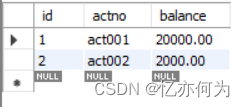
实体类:Account
/**
* 简单的账户类
*/
public class Account {
private Long id;
private String actno;
private Double balance;
public Account() {
}
public Account(Long id, String actno, Double balance) {
this.id = id;
this.actno = actno;
this.balance = balance;
}
@Override
public String toString() {
return "Account{" +
"id=" + id +
", actno='" + actno + '\'' +
", balance=" + balance +
'}';
}
public Long getId() {
return id;
}
public void setId(Long id) {
this.id = id;
}
public String getActno() {
return actno;
}
public void setActno(String actno) {
this.actno = actno;
}
public Double getBalance() {
return balance;
}
public void setBalance(Double balance) {
this.balance = balance;
}
}
事务概述
什么是事务:
- 在一个业务流程当中,通常需要多条DML(insert delete
update)语句共同联合才能完成,这多条DML语句必须同时成功,或者同时失败,这样才能保证数据的安全。 - 多条DML要么同时成功,要么同时失败,这叫做事务。
- 事务:Transaction(tx)
事务的四个处理过程:
- 第一步:开启事务 (start transaction)
- 第二步:执行核心业务代码
- 第三步:提交事务(如果核心业务处理过程中没有出现异常)(commit transaction)
- 第四步:回滚事务(如果核心业务处理过程中出现异常)(rollback transaction)
事务的四个特性:
- A 原子性:事务是最小的工作单元,不可再分。
- C 一致性:事务要求要么同时成功,要么同时失败。事务前和事务后的总量不变。
- I 隔离性:事务和事务之间因为有隔离性,才可以保证互不干扰。
- D 持久性:持久性是事务结束的标志。
引入事务场景
以银行账户转账为例。两个账户act-001和act-002。act-001账户向act-002账户转账,必须同时成功,或者同时失败。(一个减成功,一个加成功, 这两条update语句必须同时成功,或同时失败。)
连接数据库的技术采用Spring框架的JdbcTemplate。
采用三层架构搭建:
第一步:准备环境
相关依赖、数据库表(t_act)及数据、实体类(Account)
第二步:编写持久层
创建dao包,在dao包下创建接口:AccountDao
/**
* 专门负责账户信息的CRUD操作,不和业务挂钩
*/
public interface AccountDao {
/**
* 根据账号查询账户信息
* @param actno
* @return
*/
Account selectByActno(String actno);
/**
* 更新账户信息
* @param act
* @return
*/
int update(Account act);
}
在dao层下,创建impl包,新建AccountDao的实现类:AccountDaoImpl
@Repository("accountDao")
public class AccountDaoImpl implements AccountDao {
@Resource(name = "jdbcTemplate")
private JdbcTemplate jdbcTemplate;
@Override
public Account selectByActno(String actno) {
String sql = "select * from t_act where actno = ?";
Account account = jdbcTemplate.queryForObject(sql, new BeanPropertyRowMapper<>(Account.class), actno);
return account;
}
@Override
public int update(Account act) {
String sql = "update t_act set balance = ? where actno = ?";
int update = jdbcTemplate.update(sql, act.getBalance(), act.getActno());
return update;
}
}
第三步:编写业务层
创建service包,在service包创建接口:AccountService
public interface AccountService {
/**
* 转账业务
* @param fromAct 转出账户
* @param toAct 转出账户
* @param money 转账金额
*/
void transfer(String fromAct,String toAct,double money);
}
在service层下创建impl包,编写AccountService的实现类:AccountServiceImpl
@Service("accountService")
public class AccountServiceImpl implements AccountService {
@Resource(name = "accountDao")
private AccountDao accountDao;
@Override
public void transfer(String fromActno, String toActno, double money) {
//查询转出账户余额是否充足
Account fromAccount = accountDao.selectByActno(fromAct);
if (fromAccount.getBalance() < money) {//余额不足抛异常
throw new RuntimeException("余额不足");
}
//修改内存中两个对象的余额
Account toAccount = accountDao.selectByActno(toAct);
fromAccount.setBalance(fromAccount.getBalance() - money);
toAccount.setBalance(toAccount.getBalance() + money);
//数据库更新
int count = accountDao.update(fromAccount);
//模拟异常
/*String s = null;
s.toString();*/
count += accountDao.update(toAccount);
if (count != 2) {
throw new RuntimeException("转账失败");
}
}
第四步:编写Spring配置文件
创建spring.xml:
添加组件扫描、配置jdbcTemplate、配置德鲁伊连接池
<?xml version="1.0" encoding="UTF-8"?>
<beans xmlns="http://www.springframework.org/schema/beans"
xmlns:xsi="http://www.w3.org/2001/XMLSchema-instance"
xmlns:context="http://www.springframework.org/schema/context"
xsi:schemaLocation="http://www.springframework.org/schema/beans http://www.springframework.org/schema/beans/spring-beans.xsd
http://www.springframework.org/schema/context http://www.springframework.org/schema/context/spring-context.xsd">
<!--添加组件扫描-->
<context:component-scan base-package="com.bank"/>
<!--配置jdbcTemplate-->
<bean id="jdbcTemplate" class="org.springframework.jdbc.core.JdbcTemplate">
<property name="dataSource" ref="dataSource"/>
</bean>
<!--配置德鲁伊连接池-->
<bean id="dataSource" class="com.alibaba.druid.pool.DruidDataSource">
<property name="driverClassName" value="com.mysql.cj.jdbc.Driver"/>
<property name="url" value="jdbc:mysql://localhost:3306/mvc"/>
<property name="username" value="root"/>
<property name="password" value="root"/>
</bean>
</beans>
第五步:编写表示层(测试程序)
@Test
public void testSpringTx(){
ApplicationContext applicationContext = new ClassPathXmlApplicationContext("spring.xml");
AccountService accountService = applicationContext.getBean("accountService", AccountService.class);
try {
accountService.transfer("act001","act002",1000);
System.out.println("转账成功。。。");
}catch (Exception e){
e.printStackTrace();
}
}
运行程序:

数据库数据改变:
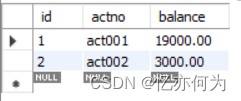
模拟异常
把在业务代码里的模拟异常松开:
@Service("accountService")
public class AccountServiceImpl implements AccountService {
@Resource(name = "accountDao")
private AccountDao accountDao;
@Override
public void transfer(String fromActno, String toActno, double money) {
//查询转出账户余额是否充足
Account fromAccount = accountDao.selectByActno(fromAct);
if (fromAccount.getBalance() < money) {//余额不足抛异常
throw new RuntimeException("余额不足");
}
//修改内存中两个对象的余额
Account toAccount = accountDao.selectByActno(toAct);
fromAccount.setBalance(fromAccount.getBalance() - money);
toAccount.setBalance(toAccount.getBalance() + money);
//数据库更新
int count = accountDao.update(fromAccount);
//模拟异常
String s = null;
s.toString();
count += accountDao.update(toAccount);
if (count != 2) {
throw new RuntimeException("转账失败");
}
}
再次运行:

数据库表中数据:
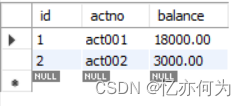
数据异常,丢失1千
Spring对事务的支持
Spring实现事务的两种方式
- 编程式事务(基本不会用)
通过编写代码的方式来实现事务的管理。 - 声明式事务
- 基于注解方式(常用)
- 基于XML配置方式(不常用)
Spring事务管理API
Spring对事务的管理底层实现方式是基于AOP实现的。采用AOP的方式进行了封装。所以Spring专门针对事务开发了一套API,API的核心接口如下:

PlatformTransactionManager接口:spring事务管理器的核心接口。在Spring6中它有两个实现:
- DataSourceTransactionManager:支持JdbcTemplate、MyBatis、Hibernate等事务管理。
- JtaTransactionManager:支持分布式事务管理。
如果要在Spring6中使用JdbcTemplate,就要使用DataSourceTransactionManager来管理事务。(Spring内置写好了,可以直接用。)
声明式事务之注解实现方式
第一步:在spring配置文件中配置事务管理器。
<!--配置事务管理器-->
<bean id="txManager" class="org.springframework.jdbc.datasource.DataSourceTransactionManager">
<!--设置数据源-->
<property name="dataSource" ref="dataSource"/>
</bean>
第二步:在spring配置文件中引入tx命名空间。
<?xml version="1.0" encoding="UTF-8"?>
<beans xmlns="http://www.springframework.org/schema/beans"
xmlns:xsi="http://www.w3.org/2001/XMLSchema-instance"
xmlns:context="http://www.springframework.org/schema/context"
xmlns:tx="http://www.springframework.org/schema/tx"
xsi:schemaLocation="http://www.springframework.org/schema/beans http://www.springframework.org/schema/beans/spring-beans.xsd
http://www.springframework.org/schema/context http://www.springframework.org/schema/context/spring-context.xsd
http://www.springframework.org/schema/tx http://www.springframework.org/schema/tx/spring-tx.xsd">
第三步:在spring配置文件中配置“事务注解驱动器”,开始注解的方式控制事务。
<!--开启事务注解驱动器,开启事务注解-->
<tx:annotation-driven transaction-manager="txManager"/>
第四步:在service类上或方法上添加@Transactional注解
@Transactional
- 写在方法上,只针对于该方法应用事务。
- 写在类上,代表这个类上所有方法应用事务。
@Override
@Transactional
public void transfer(String fromAct, String toAct, double money) {
//查询转出账户余额是否充足
Account fromAccount = accountDao.selectByActno(fromAct);
if (fromAccount.getBalance() < money) {//余额不足抛异常
throw new RuntimeException("余额不足");
}
//修改内存中两个对象的余额
Account toAccount = accountDao.selectByActno(toAct);
fromAccount.setBalance(fromAccount.getBalance() - money);
toAccount.setBalance(toAccount.getBalance() + money);
//数据库更新
int count = accountDao.update(fromAccount);
//模拟异常
String s = null;
s.toString();
count += accountDao.update(toAccount);
if (count != 2) {
throw new RuntimeException("转账失败");
}
}
执行测试程序:

虽然出现异常了,再次查看数据库表中数据:

发现数据没有变化,事务起作用了。
事务属性
事务属性包括哪些
我们可以查看一下@Transactional注解源码:
@Target({ElementType.TYPE, ElementType.METHOD})
@Retention(RetentionPolicy.RUNTIME)
@Inherited
@Documented
public @interface Transactional {
@AliasFor("transactionManager")
String value() default "";
@AliasFor("value")
String transactionManager() default "";
String[] label() default {};
Propagation propagation() default Propagation.REQUIRED;
Isolation isolation() default Isolation.DEFAULT;
int timeout() default -1;
String timeoutString() default "";
boolean readOnly() default false;
Class<? extends Throwable>[] rollbackFor() default {};
String[] rollbackForClassName() default {};
Class<? extends Throwable>[] noRollbackFor() default {};
String[] noRollbackForClassName() default {};
}
有很多的属性,我们只关注重点属性:
事务中的重点属性:
- 事务传播行为 propagation()
- 事务隔离级别 isolation()
- 事务超时 timeout()
- 只读事务 readOnly()
- 设置出现哪些异常回滚事务 rollbackFor()
- 设置出现哪些异常不回滚事务 noRollbackFor()
事务传播行为
什么是事务的传播行为?
例如在service类中有a()方法和b()方法,a()方法上有事务,b()方法上也有事务,当a()方法执行过程中调用了b()方法,事务是如何传递的?合并到一个事务里?还是开启一个新的事务?这就是事务传播行为。
事务传播行为在spring框架中被定义为枚举类型:
public enum Propagation {
REQUIRED(0),
SUPPORTS(1),
MANDATORY(2),
REQUIRES_NEW(3),
NOT_SUPPORTED(4),
NEVER(5),
NESTED(6);
private final int value;
private Propagation(int value) {
this.value = value;
}
public int value() {
return this.value;
}
}
一共有七种传播行为:
-
REQUIRED:支持当前事务,如果不存在就新建一个(默认)
没有就新建,有就加入 -
SUPPORTS:支持当前事务,如果当前没有事务,就以非事务方式执行
有就加入,没有就不管了 -
MANDATORY:必须运行在一个事务中,如果当前没有事务正在发生,将抛出一个异常
有就加入,没有就抛异常 -
REQUIRES_NEW:开启一个新的事务,如果一个事务已经存在,则将这个存在的事务挂起
不管有没有,直接开启一个新事务,开启的新事务和之前的事务不存在嵌套关系,之前事务被挂起 -
NOT_SUPPORTED:以非事务方式运行,如果有事务存在,挂起当前事务
不支持事务,存在就挂起 -
NEVER:以非事务方式运行,如果有事务存在,抛出异常
不支持事务,存在就抛异常 -
NESTED:如果当前正有一个事务在进行中,则该方法应当运行在一个嵌套式事务中。被嵌套的事务可以独立于外层事务进行提交或回滚。如果外层事务不存在,行为就像REQUIRED一样。
有事务的话,就在这个事务里再嵌套一个完全独立的事务,嵌套的事务可以独立的提交和回滚。没有事务就和REQUIRED一样。
演示程序
需要在数据库中新增两个账户,在一个保存方法里调用另一个保存方法。
首先在持久层接口添加方法,并在实现类实现:
AccountDao接口新增方法:
/**
* 新增账户信息
* @param act
* @return
*/
int insert(Account act);
AccountDaoImpl实现:
@Override
public int insert(Account act) {
String sql = "insert into t_act values(null,?,?)";
int count = jdbcTemplate.update(sql, act.getActno(), act.getBalance());
return count;
}
在业务层接口添加方法,及实现类实现:
AccountService接口:
/**
* 保存账户信息
* @param act
*/
void save(Account act);
新增第二个实现类:AccountServiceImpl2
@Service("accountService2")
public class AccountServiceImpl2 implements AccountService {
@Resource(name = "accountDao")
private AccountDao accountDao;
@Override
public void transfer(String fromAct, String toAct, double money) {
}
@Override
@Transactional(propagation = Propagation.REQUIRED)
public void save(Account act) {
accountDao.insert(act);
//模拟异常
/*String s = null;
s.toString();*/
}
}
AccountServiceImpl实现方法:调用AccountServiceImpl2的save方法
@Resource(name = "accountService2")
private AccountService accountService;
@Override
@Transactional(propagation = Propagation.REQUIRED)
public void save(Account act) {
//先保存act账户
accountDao.insert(act);
//再保存act2账户
Account act2 = new Account();
act2.setActno("act-004");
act2.setBalance(1000.0);
try {
accountService.save(act2);//调用AccountServiceImpl2的save方法
}catch (Exception e){
}
}
测试程序:
@Test
public void testPropagation(){
ApplicationContext applicationContext = new ClassPathXmlApplicationContext("spring.xml");
AccountService accountService = applicationContext.getBean("accountService", AccountService.class);
Account account = new Account();
account.setActno("act-003");
account.setBalance(10000.0);
accountService.save(account);
}

可以看见在两个SQL语句之间,Participating in existing transaction,翻译为:参与现有交易,实际上就是加入事务了,查看数据库数据:

正常插入。
如果把AccountServiceImpl2模拟注释松开:
@Override
@Transactional(propagation = Propagation.REQUIRED)
public void save(Account act) {
accountDao.insert(act);
//模拟异常
String s = null;
s.toString();
}
发生异常了,回滚事务

数据库数据不改变:

如果把AccountServiceImpl2的事务传播类型换成REQUIRES_NEW
@Override
//@Transactional(propagation = Propagation.REQUIRED)
@Transactional(propagation = Propagation.REQUIRES_NEW)
public void save(Account act) {
accountDao.insert(act);
//模拟异常
String s = null;
s.toString();
}
再次运行:

可以看见在两个SQL语句之间,Suspending current transaction, creating new transaction with name,翻译为:正在挂起当前事务,正在创建名为的新事务
并且事务2发生异常回滚了,然后
Resuming suspended transaction after completion of inner transaction
Initiating transaction commit
翻译为:
内部事务完成,恢复暂停的事务
启动事务提交
也就是说事务1不会受到事务2的影响,并且如果事务2发生异常,进行捕获,也捕获不到,发生异常后会自动回滚,事务1恢复,并且进行往下执行。
查看数据库:只新增了事务1的账户

余下的事务传播行为就不演示了。
事务隔离级别
数据库中读取数据存在的三大问题:(三大读问题)
- 脏读:读取到没有提交到数据库的数据,叫做脏读。
- 不可重复读:在同一个事务当中,第一次和第二次读取的数据不一样。
- 幻读:读到的数据是假的。
事务隔离级别包括四个级别:
- 读未提交:READ_UNCOMMITTED
这种隔离级别,存在脏读问题,所谓的脏读(dirty read)表示能够读取到其它事务未提交的数据。 - 读提交:READ_COMMITTED
解决了脏读问题,其它事务提交之后才能读到,但存在不可重复读问题。 - 可重复读:REPEATABLE_READ
解决了不可重复读,可以达到可重复读效果,只要当前事务不结束,读取到的数据一直都是一样的。但存在幻读问题。 - 序列化:SERIALIZABLE
解决了幻读问题,事务排队执行。不支持并发。
表格归纳:
| 隔离级别 | 脏读 | 不可重复读 |
|---|---|---|
| 读未提交 | 有 | 有 |
| 读提交 | 无 | 有 |
| 可重复读 | 无 | 无 |
| 序列化 | 无 | 无 |
隔离级别在spring中也是以枚举类型存在:
public enum Isolation {
DEFAULT(-1),
READ_UNCOMMITTED(1),
READ_COMMITTED(2),
REPEATABLE_READ(4),
SERIALIZABLE(8);
private final int value;
private Isolation(int value) {
this.value = value;
}
public int value() {
return this.value;
}
}
- DEFAULT:
这是一个PlatfromTransactionManager默认的隔离级别,使用数据库默认的事务隔离级别。另外四个与JDBC的隔离级别相对应 - READ_UNCOMMITTED: 读未提交
- READ_COMMITTED:读提交
- REPEATABLE_READ: 可重复读
- SERIALIZABLE:序列化
演示程序
一个service负责插入,一个service负责查询。负责插入的service要模拟延迟。
创建AccountServiceImpl3类,不实现接口了,负责查询:
/**
* 演示隔离级别
* 3号负责查询,4号负责插入
*/
@Service("accountService3")
public class AccountServiceImpl3 {
@Resource(name = "accountDao")
private AccountDao accountDao;
/**
* 根据账户查询
* @param actno
*/
@Transactional(isolation = Isolation.READ_UNCOMMITTED)
public void getByActno(String actno){
Account account = accountDao.selectByActno(actno);
System.out.println("账户信息:" + account);
}
}
创建AccountServiceImpl4类,不实现接口了,负责插入:
@Service("accountService4")
public class AccountServiceImpl4 {
@Resource(name = "accountDao")
private AccountDao accountDao;
@Transactional
public void save(Account act){
accountDao.insert(act);
//让程序睡眠一会
try {
Thread.sleep(1000 * 20);
} catch (InterruptedException e) {
e.printStackTrace();
}
}
}
测试程序:
@Test
public void testIsolation1() {
ApplicationContext applicationContext = new ClassPathXmlApplicationContext("spring.xml");
AccountServiceImpl4 accountService4 = applicationContext.getBean("accountService4", AccountServiceImpl4.class);
Account account = new Account();
account.setActno("act-003");
account.setBalance(50000.0);
accountService4.save(account);
}
@Test
public void testIsolation2(){
ApplicationContext applicationContext = new ClassPathXmlApplicationContext("spring.xml");
AccountServiceImpl3 accountService3 = applicationContext.getBean("accountService3", AccountServiceImpl3.class);
accountService3.getByActno("act-003");
}
执行前需要把数据库数据删除到初始数据。

先执行testIsolation1,在执行testIsolation2
testIsolation1:

testIsolation2:读到了未提交的数据

等testIsolation1执行完后查看数据库数据:

余下的隔离级别就不演示了。
事务超时
事务超时:使用timeout=整数设置,表示超过多少秒如果该事务中所有的DML语句还没有执行完毕的话,最终结果会选择回滚。默认值是-1,表示没有时间限制。
- 最后一条DML语句执行之后的时间就不会被记录到超时时间里。
- 反之在最后一条DML语句执行之前的时间就会被记录到超时时间里。
演示程序
在AccountServiceImpl4里设置事务超时
在最后一条DML语句执行之后让程序睡眠情况:
//@Transactional
@Transactional(timeout = 10)//设置超时事务10秒
public void save(Account act) throws IOException {
accountDao.insert(act);
//让程序睡眠一会
try {
Thread.sleep(1000 * 20);
} catch (InterruptedException e) {
e.printStackTrace();
}
}
运行测试程序testIsolation1:

事务提交了,睡眠程序没有计入超时时间,查看数据库数据:成功插入数据
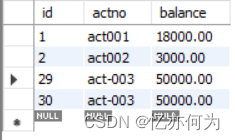
如果想让整个方法的所有代码都计入超时时间的话,可以在方法最后一行添加一行无关紧要的DML语句。
在最后一条DML语句执行之前让程序睡眠情况:
//@Transactional
@Transactional(timeout = 10)
public void save(Account act){
try {
Thread.sleep(1000 * 20);
} catch (InterruptedException e) {
e.printStackTrace();
}
accountDao.insert(act);
//让程序睡眠一会
/*try {
Thread.sleep(1000 * 20);
} catch (InterruptedException e) {
e.printStackTrace();
}*/
}
再次运行测试程序testIsolation1:

睡眠时间计入超时时间,事务超时,进行了回滚,数据库数据:原封不动

只读事务
使用readOnly = ture|false 配置,默认未false
将当前事务设置为只读事务,在该事务执行过程中只允许select语句执行,delete insert update均不可执行。
该特性的作用是:启动spring的优化策略。提高select语句执行效率。
如果该事务中确实没有增删改操作,建议设置为只读事务。
演示程序
在AccountServiceImpl4里设置为只读事务
//@Transactional
//@Transactional(timeout = 10)
@Transactional(readOnly = true)
public void save(Account act) throws IOException {
/*try {
Thread.sleep(1000 * 20);
} catch (InterruptedException e) {
e.printStackTrace();
}*/
accountDao.insert(act);
//让程序睡眠一会
/*try {
Thread.sleep(1000 * 20);
} catch (InterruptedException e) {
e.printStackTrace();
}*/
}
运行测试程序testIsolation1:
出现异常,说Connection是只读的,也就是事务是只读的,不允许导致数据修改

数据库数据不变:

设置哪些异常回滚事务
使用rollbackFor = {异常1.class,异常2.class,...}进行设置,表示只有发生异常或该异常的子类异常才回滚。默认为空,表示所有异常都回滚。
演示程序
在AccountServiceImpl4里设置:
//@Transactional
//@Transactional(timeout = 10)
//@Transactional(readOnly = true)
@Transactional(rollbackFor = RuntimeException.class)//只要发生RuntimeException或者这个子类的异常,都回滚
public void save(Account act) throws IOException {
/*try {
Thread.sleep(1000 * 20);
} catch (InterruptedException e) {
e.printStackTrace();
}*/
accountDao.insert(act);
//模拟异常
//throw new IOException();//IO异常是编译时异常
throw new RuntimeException();
//让程序睡眠一会
/*try {
Thread.sleep(1000 * 20);
} catch (InterruptedException e) {
e.printStackTrace();
}*/
}
运行测试程序testIsolation1:

数据库数据不变:

把异常改为其他异常,把另一个异常注释松开,注释RuntimeException异常,再次运行程序:

出现异常,但是事务提交了,数据库数据改变:
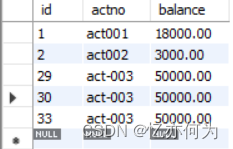
设置哪些异常不回滚事务
使用norollbackFor = {异常1.class,异常2.class,...}进行设置,表示发生该异常或该异常的子类异常不回滚,其他异常则回滚,默认为空,表示所有异常都回滚。
演示程序
还是修改AccountServiceImpl4:
//@Transactional
//@Transactional(timeout = 10)
//@Transactional(readOnly = true)
//@Transactional(rollbackFor = RuntimeException.class)//只要发生RuntimeException或者这个子类的异常,都回滚
@Transactional(noRollbackFor = NullPointerException.class)
public void save(Account act) throws IOException {
/*try {
Thread.sleep(1000 * 20);
} catch (InterruptedException e) {
e.printStackTrace();
}*/
accountDao.insert(act);
//模拟异常
//throw new IOException();//IO异常是编译时异常
//throw new RuntimeException();
throw new NullPointerException();
//让程序睡眠一会
/*try {
Thread.sleep(1000 * 20);
} catch (InterruptedException e) {
e.printStackTrace();
}*/
}
运行测试程序testIsolation1:

发生了空指针异常,但是事务提交了,数据库数据改变:
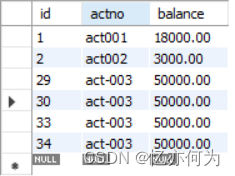
把异常改为其他异常,把另一个RuntimeException异常注释松开,注释NullPointerException异常,再次运行程序:

发生异常,但是回滚了,数据库数据不变:

事务的全注解式开发
编写一个类来代替配置文件,怎么编写jdbcTemplate、德鲁伊数据源、事务管理器这些Bean呢?
可以在配置文件编写方法使用@Bean注解修饰,Bean的id就使用name属性设置。
Spring框架看到这个@Bean注解的时候,会调用这个注解标注的方法,返回该方法的对象,该对象会自动纳入IoC容器管理。
这个返回值就是Spring容器的Bean对象了,并且这个Bean对象的名字就是name。
这些Bean的属性是怎么注入呢?
简单类型的属性可以使用注解的value进行配置
如果注入非简单类型的话,它是一个Bean,有两种注入方式
- 1.想要注入哪个Bean,可以调用@Bean标注的那个方法
- 2.通过参数传递,在方法@Bean标注的方法里设置一个参数,这个参数是你要注入的类型,Spring框架会自动寻找这个类型的Bean,传给这个方法使用。
一般非简单类型使用第二种设置
@Configuration// 代替Spring配置文件
@ComponentScan("com.bank")// 代替组件扫描
@EnableTransactionManagement //开启事务注解
public class SpringConfig {
@Bean(name = "jdbcTemplate")
public JdbcTemplate getJdbcTemplate(DataSource dataSource){
JdbcTemplate jdbcTemplate = new JdbcTemplate();
//两种注入方式
//jdbcTemplate.setDataSource(getDruidDataSource());
jdbcTemplate.setDataSource(dataSource);
return jdbcTemplate;
}
@Bean(name = "dataSource")
public DruidDataSource getDruidDataSource(){
DruidDataSource dataSource = new DruidDataSource();
dataSource.setDriverClassName("com.mysql.cj.jdbc.Driver");
dataSource.setUrl("jdbc:mysql://localhost:3306/mvc");
dataSource.setUsername("root");
dataSource.setPassword("root");
return dataSource;
}
@Bean(name = "txManager")
public DataSourceTransactionManager getDataSourceTransactionManager(DataSource dataSource){
DataSourceTransactionManager transactionManager = new DataSourceTransactionManager();
transactionManager.setDataSource(dataSource);
return transactionManager;
}
}
测试还是使用账户转账,把异常去掉:
@Test
public void testNoXML(){
ApplicationContext applicationContext = new AnnotationConfigApplicationContext(SpringConfig.class);
AccountService accountService = applicationContext.getBean("accountService", AccountService.class);
try {
accountService.transfer("act001","act002",1000);
System.out.println("转账成功。。。");
}catch (Exception e){
e.printStackTrace();
}
}

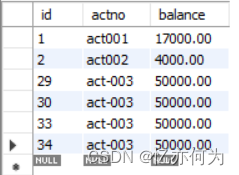
声明式事务之XML实现方式
测试的话还是使用账户转账。
配置步骤:
- 第一步:基础配置
- 第二步:配置通知
- 第三步:配置切面
记得添加aspectj的依赖:
<!--aspectj依赖-->
<dependency>
<groupId>org.springframework</groupId>
<artifactId>spring-aspects</artifactId>
<version>6.0.0-M2</version>
</dependency>
第一步:基础配置
**添加aop的命名空间。**为后面配置通知和切面做准备。
并且配置组件扫描、配置jdbcTemplate、配置德鲁伊连接池、配置事务管理器
<?xml version="1.0" encoding="UTF-8"?>
<beans xmlns="http://www.springframework.org/schema/beans"
xmlns:xsi="http://www.w3.org/2001/XMLSchema-instance"
xmlns:context="http://www.springframework.org/schema/context"
xmlns:tx="http://www.springframework.org/schema/tx"
xmlns:aop="http://www.springframework.org/schema/aop"
xsi:schemaLocation="http://www.springframework.org/schema/beans http://www.springframework.org/schema/beans/spring-beans.xsd
http://www.springframework.org/schema/context http://www.springframework.org/schema/context/spring-context.xsd
http://www.springframework.org/schema/tx http://www.springframework.org/schema/tx/spring-tx.xsd
http://www.springframework.org/schema/aop http://www.springframework.org/schema/aop/spring-aop.xsd">
<!--添加组件扫描-->
<context:component-scan base-package="com.bank"/>
<!--配置jdbcTemplate-->
<bean id="jdbcTemplate" class="org.springframework.jdbc.core.JdbcTemplate">
<property name="dataSource" ref="dataSource"/>
</bean>
<!--配置德鲁伊连接池-->
<bean id="dataSource" class="com.alibaba.druid.pool.DruidDataSource">
<property name="driverClassName" value="com.mysql.cj.jdbc.Driver"/>
<property name="url" value="jdbc:mysql://localhost:3306/mvc"/>
<property name="username" value="root"/>
<property name="password" value="root"/>
</bean>
<!--配置事务管理器-->
<bean id="txManager" class="org.springframework.jdbc.datasource.DataSourceTransactionManager">
<!--设置数据源-->
<property name="dataSource" ref="dataSource"/>
</bean>
</beans>
第二步:配置通知
配置通知:使用tx:advice标签
- id属性:唯一标识
- transaction-manager:配置关联事务管理器
在tx:advice标签里面配置通知的相关属性,使用<tx:attributes>嵌套<tx:method>标签配置
之前说的所有的事务属性都可以在<tx:method>标签以属性的方式配置
如果方法比较多可以采用通配符的方式进行模糊匹配配置
例如<tx:method name="save*"/> 就是save开始发方法都需要进行事务管理
<tx:advice id="txAdive" transaction-manager="txManager">
<tx:attributes>
<tx:method name="transfer"/>
<tx:method name="save*"/>
</tx:attributes>
</tx:advice>
第三步:配置切面
配置切点:使用<aop:pointcut>标签配置
- id属性:唯一标识
- expression:切点表达式
配置切面:等于通知加切点,使用<aop:advisor>标签配置
- advice-ref属性:通知的id
- pointcut-ref属性:切点的id
<!--配置切面-->
<aop:config>
<aop:pointcut id="txPointcut" expression="execution(* com.bank.service..*(..))"/>
<aop:advisor advice-ref="txAdive" pointcut-ref="txPointcut"/>
</aop:config>
测试
将AccountServiceImpl类上的@Transactional注解注释或删除。并且模拟异常
测试程序:
@Test
public void testXML(){
ApplicationContext applicationContext = new ClassPathXmlApplicationContext("spring.xml");
AccountService accountService = applicationContext.getBean("accountService", AccountService.class);
try {
accountService.transfer("act001","act002",1000);
System.out.println("转账成功。。。");
}catch (Exception e){
e.printStackTrace();
}
}

数据库数据:
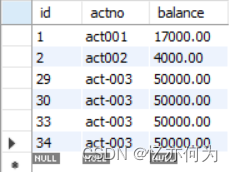
通过测试可以看到配置XML已经起作用了。
























 5588
5588











 被折叠的 条评论
为什么被折叠?
被折叠的 条评论
为什么被折叠?










